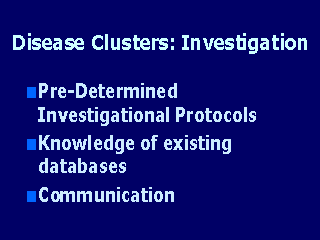 |
The key ingredients to a successful disease cluster investigation
include the following. It is important to have pre-determined
investigational protocols established which describe the exact steps
that need to be taken to investigate a disease cluster, whether
traditional or occupational. The US Centers for Diseases Control and
Prevention (CDC) has published literature which sets out protocols for
the investigation of disease clusters from the point of view of public
health authorities. Knowledge of existing databases which can rapidly
provide baseline rates of particular causes of morbidity and mortality
is essential. Such databases include cancer registries and local
public health statistics. In addition, use of Geographic Information
Services (GIS), is a useful tool to modeling time and space information,
especially for traditional environmental or community disease clusters.
Finally, constant communication with the affected populations is
crucial. It is important to communicate the investigational protocols
and the limited outcome to be expected from disease cluster
investigations. In particular, it is particularly important to
communicate the issues of chance and hypothesis generation. It is
also recommended that the target populations for communication be
identified early and broadly. For example, in an occupational cluster
investigation this could include: the workers, the union, management,
the press, the community, and the regulatory agencies.
|
